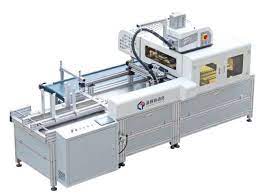Skip to content

In the ever-evolving landscape of the manufacturing industry, the introduction of virtual reality (VR) and collaborative robotics (cobots) into box assembly machinery represents a groundbreaking shift towards more interactive, efficient, and adaptable production processes. This integration not only propels the capabilities of box assembly to new heights but also sets a benchmark for the future of automated manufacturing. This article delves into the transformative impact of combining VR and cobots in box assembly machinery, outlining a vision for a smarter, more flexible, and human-centric approach to packaging automation.
- Virtual Reality for Immersive Training and Simulation:
- Virtual reality technology is revolutionizing the way operators interact with box assembly machinery. By creating an immersive 3D simulation of the assembly process, VR allows for comprehensive training outside the constraints of the physical production floor. This not only accelerates the learning curve for new operators but also enables experienced personnel to refine their skills and experiment with system optimizations without interrupting production. Furthermore, VR simulations can be used to design and test new packaging concepts quickly, significantly reducing the time and material waste associated with physical prototypes.
- Collaborative Robotics for Enhanced Flexibility and Efficiency:
- The deployment of cobots in box assembly lines introduces a new level of flexibility and efficiency. Unlike traditional industrial robots, cobots are designed to work alongside human operators safely, without the need for extensive safety barriers. This allows for a more integrated approach to box assembly, where humans and robots can share tasks and responsibilities. Cobots are adept at handling repetitive, precise tasks with consistency, freeing up human workers to focus on more complex or variable aspects of the assembly process. This collaborative workflow not only boosts productivity but also enhances job satisfaction among workers.
- Adaptive Production Lines with Real-Time Feedback:
- Integrating cobots and VR into box assembly machinery paves the way for adaptive production lines that can respond in real-time to changes in production demands or design specifications. Cobots equipped with sensors provide continuous feedback on the assembly process, which can be visualized and analyzed through VR interfaces. This real-time data flow enables rapid adjustments to be made, ensuring optimal efficiency and reducing downtime. The ability to quickly reconfigure assembly lines for different box sizes or designs without extensive manual intervention marks a significant advancement in manufacturing flexibility.
- Sustainability Through Precision and Waste Reduction:
- The precision of cobots and the predictive capabilities of VR-based simulations contribute significantly to sustainability efforts. By optimizing material usage and reducing the incidence of errors or defects, these technologies help minimize waste throughout the assembly process. Additionally, the energy efficiency of cobots and the reduced need for physical materials in VR training and testing further align box assembly practices with environmental sustainability goals.
- Enhancing Safety and Ergonomics:
- The safety and ergonomic benefits of integrating cobots and VR into box assembly machinery cannot be overstated. Cobots are inherently designed to ensure safe interaction with human operators, reducing the risk of workplace injuries associated with heavy lifting or repetitive motion. Similarly, VR training minimizes the need for physical exertion during the learning process, offering a safer and more comfortable training environment.


